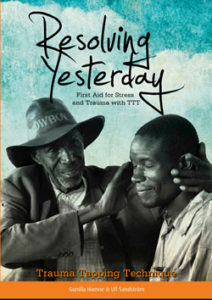Resolving Yesterday: First Aid for Stress and Trauma with TTT is a book designed to teach the Trauma Tapping Technique (TTT), a stress management and coping tool that can be performed on the self and others. Designed to be as accessible as possible so that the technique can reach people of disparate levels of education, experience, and language, the book teaches the technique while also framing for readers its applications in several modern conflict areas. Supplementary meditative techniques are also explained here, via diagrams and guides that anybody can learn with minimal difficulty. There is also a heavy emphasis throughout on sharing the technique with others, with extensive guides offered on how to teach it to one or more people at a time. There are some clinical explanations and linkages also included for professional readers, but the emphasis is on wide accessibility. Vignettes of success stories abound, and there is a tendency towards narrative confidence when describing the efficacy of the technique for healing and application to diverse traumatized populations. Although much of the information presented is available online at the authors’ website (www.peacefulheart.se), proceeds from the book are used to fund further books for those who cannot otherwise afford them.
Resolving Yesterday is designed for simplicity, expediency, and accessibility for a diverse target audience. This was done so that it could be used in Uganda and the Congo for sufferers of PTSD and witnesses of the genocides that occurred in those areas without relying heavily on lingual instructions. Much of the technique is explained in the opening of the book through diagram and written instructions, but readers are also encouraged to go online and see videos of it being used, which can assist in understanding how to perform it. There is emphasis throughout on the various applications of the technique, with a broad focus on affect management; the book characterizes the tapping technique as a form of first aid for trauma that can also be applied to oneself. It begins by instructing readers how to first perform the technique on themselves, then on how to offer TTT sessions to others with simplified metaphorical explanations offered for those skeptical about trying it. Group sessions and teaching are also covered extensively. The next portion of the book covers the many forms of stress and includes several stories that illustrate the backgrounds of people that have been helped by the technique, including, for example, sex slaves and former child soldiers. An additional techniques section follows with other exercises like expanded tapping options, stress massages, and breathing techniques to help stress. The end of the book discusses the efforts of the people who have been applying TTT to conflict areas around the world.
Clinically, TTT is a compelling tool that has widespread application despite its simplicity of execution and its short duration, about 3-10 minutes. The book itself is a great resource for diverse readership, and even though the language and approach is slanted towards those with far less clinical experience than professionals would have, it is nonetheless a practical clinical guide. Because much of the information presented here is available for free online, actually purchasing the book is somewhat unnecessary unless the background of the technique and how it has been applied is of interest, or if the charitable aspect of the purchase is something of importance to readers. Practitioners looking to incorporate supplementary healing techniques into their practice or even seeking to teach patients simple stress management techniques will find the book very helpful. Those already using bodywork and alternative therapy in their practice can similarly deepen the efficacy of their work.
Gunilla Hamne is a former journalist who works in Africa and around the world teaching TTT. Ulf Sandström is a hypnotherapist and coach who began using TTT when language barriers caused frequent roadblocks in his work with trauma sufferers in African regions with multiple dialects.
 Hamne, G. & Sandström, U. (2015). Resolving Yesterday: First Aid For Stress And Trauma With TTT. Amazon.
Hamne, G. & Sandström, U. (2015). Resolving Yesterday: First Aid For Stress And Trauma With TTT. Amazon.
ISBN: 978-1-505-32671-0.
Paperback. 227 pages. Includes index, glossary, recommended reading, and references.
Key words: tapping, trauma, ptsd, bodywork, alternative therapy, stress







